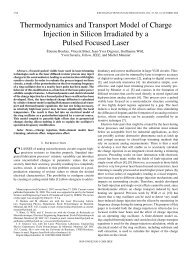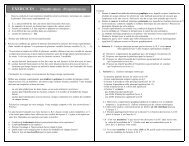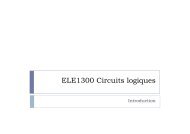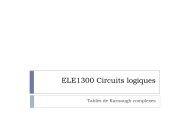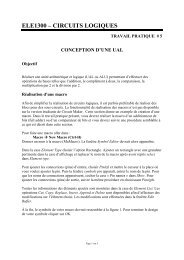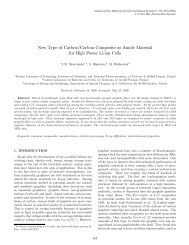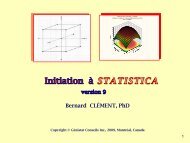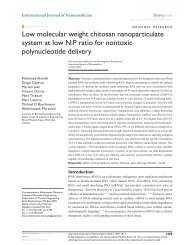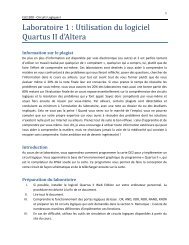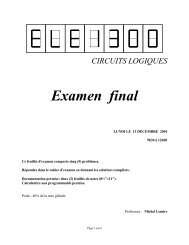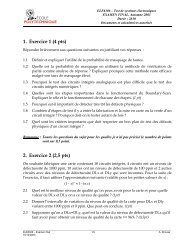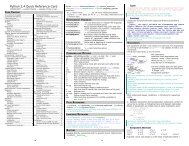Create successful ePaper yourself
Turn your PDF publications into a flip-book with our unique Google optimized e-Paper software.
Journal of New Materials for Electrochemical Systems 10, 81-89 (2007)<br />
© J. New Mat. Electrochem. Systems<br />
Binary Pt– and Pd–based Electrocatalysts for Oxidation<br />
of Hydrogen with Co Admixtures<br />
* K. V. <strong>Rybalka</strong> 1 , M. R. Tarasevich 1 , B. M. Grafov 1 , V. A. Bogdanovskaya 1 , L. A. Beketaeva 1 ,<br />
E. N. Loubnin 1 and Yu. A. Kolbanovskii 2<br />
1 A.N. Frumkin Institute of Physical Chemistry and Electrochemistry, RAS, Moscow 119071, Leninsky pr.31, Russia<br />
2 A.I. Topchiev Institute of Petrochemical Synthesis, RAS, Moscow 119991 Leninsky pr.29, Russia<br />
Received: April 15, 2005, Accepted: December 20, 2006<br />
Abstract: The results are presented of studying the electrochemical and electrocatalytic properties of binary hydrogen electrooxidation<br />
catalysts including Pt or Pd and some other metal (Au, Mo, Ru) and tolerant towards CO admixtures. The methods of catalyst synthesis at<br />
the dispersed carbon carrier (XC72) are suggested, the binary system structure is studied. According to the results of the studies by the<br />
electrochemical impedance method, the quantitative estimation is performed for the developed catalysts of their tolerance towards CO<br />
admixtures. PdAu catalyst features the highest tolerance, which can result from the decoration of palladium surface by gold. The decoration<br />
of Pd nanoparticles by gold hinders CO adsorption while seemingly preserving enough accessible sites for hydrogen adsorption. In<br />
PdRu binary system, the tolerance is probably provided by the formation of an alloy, at which the oxidative desorption of CO is considerably<br />
facilitated in comparison with pure Pd.<br />
Keywords: : electrooxydation,catalyst,tolerance,impedance spectra<br />
1. INTRODUCTION<br />
Gas diffusion hydrogen electrodes with dispersed platinum content<br />
of 0.1–0.2 mg/cm 2 demonstrate excellent characteristics when<br />
pure hydrogen is used, but are poisoned already with traces of CO.<br />
The problem of employing gaseous hydrogen with CO admixtures<br />
in fuel cells (FC) was first studied in the 80-s [1,2] when it was<br />
shown that CO admixture of 10 ppm caused the voltage decrease<br />
of 0.2 – 0.3 V at the load of 0.8 A/cm 2 . At the load of 0.2 A/cm 2 at<br />
80 ºC the presence of CO in hydrogen, its amount being 250 ppm,<br />
leads to a drastic voltage drop of 0.4 V [3]. CO concentration in<br />
hydrogen obtained in the reforming process after its additional<br />
purification by means of the shift method usually constitutes from<br />
20 to 100 ppm. The inhibiting effect of CO on the hydrogen electrooxidation<br />
process results from the fact that the bonding strength<br />
of Pt–CO is higher than that of Pt–H [4], which complicates the<br />
dissociative hydrogen adsorption on platinum and its further ionization.<br />
At present, two possibilities of eliminating or decreasing the<br />
poisoning effect of CO presence in hydrogen are considered. The<br />
*To whom correspondence should be addressed:<br />
first of them is the increase of FC working temperature. It is<br />
shown experimentally in work [5] that at the temperature of hydrogen–oxygen<br />
FC being close to 200 ºC the specific parameters do<br />
not change even at CO content of 20000-30000 ppm. The second<br />
way is based on the development of new anodic catalysts tolerant<br />
towards CO admixtures in hydrogen, while retaining the construction<br />
and functioning conditions of FC.<br />
Platinum modification by adatoms [6] and, later, the decoration<br />
of its surface by metal submonolayers [7,8] seemed to be a prospective<br />
way of purposeful optimization of platinum properties in<br />
respect to CO oxidation. However, such systems are rather unstable<br />
in the conditions of FC functioning. Therefore, despite the<br />
importance of these studies for understanding the mechanism of<br />
electrocatalysis, they can hardly possess any practical value.<br />
At present it seems most prospective to use as electrocatalysts<br />
the binary systems based on platinum group metals which results<br />
in lower surface coverage by adsorbed CO. Such systems can be<br />
obtained by employing the methods of fusing, codeposition, thermochemical<br />
and mechanochemical synthesis, cathodic deposition<br />
etc. The most trustworthy and reproducible effects of increasing<br />
the tolerance towards CO admixtures in gaseous hydrogen were<br />
obtained by introducing Ru admixtures into Pt. As shown in [8, 9]<br />
81
82 K. V. <strong>Rybalka</strong> et al. / J. New Mat. Electrochem. Systems<br />
by means of STM and IR spectroscopy, the minimum oxidation<br />
overpotential of linearly adsorbed CO ads is achieved for the system<br />
of Pt 0.5 Ru 0.5 . According to [8], the promoting effect of Ru in the<br />
system of Pt–Ru also manifests itself in the absence of the alloy<br />
formation. The optimum ratio of Pt 0.5 Ru 0.5 was confirmed in a<br />
number of works [10–13], in particular, at the example of commercial<br />
E–TEK catalyst. The system of PtMo also proved to be of<br />
interest [7,12,14–16]. In papers [17,18] it was shown at well–<br />
characterized smooth PtMo surfaces that the presence of 20–25 at.<br />
% Mo accelerates the oxidative removal of CO and facilitates the<br />
adsorption of hydrogen. These data were confirmed by using<br />
PtMo system with the ratio of 4:1 on carbon black XC72 [14].<br />
Later in [15], the authors specified the optimum composition by<br />
increasing Mo content in PtMo system up to 3:1.<br />
Pd–based electrocatalytic systems are of real interest alongside<br />
with Pt catalysts. In [19], a method of PdAu black synthesis on<br />
carbon black XC72 is offered. In the case of these catalysts, hydrogen<br />
adsorption is observed at Pd atoms in the range of potentials<br />
of 0.05–0.3 V, same as the well–expressed limiting diffusion<br />
current of hydrogen oxidation at the rotating disc electrode [20].<br />
In respect to CO oxidation, the properties of PdAu are close to<br />
those of PtRu, but CO oxidation rate is somewhat lower. The advantages<br />
of PdAu system as compared to PtRu are better manifested<br />
at the conditions of 60 ºC and CO concentration in the<br />
range of 250–1000 ppm. It was demonstrated [21] that at the content<br />
of Au > 70% in PdAu alloys hydrogen adsorption is not<br />
observed. A conclusion was made as to its occurring only at Pd<br />
atoms. Herewith, CO adsorption on gold is also negligible [22].<br />
This system can probably turn out to be tolerant towards CO and<br />
at the same time to be active towards hydrogen electrooxidation.<br />
In the present work, the possibility is considered of developing<br />
Pt– and Pd–based binary catalysts of hydrogen oxidation that are<br />
tolerant towards CO admixtures. The electrocatalytic properties of<br />
such systems were compared both as to pure hydrogen oxidation<br />
and the oxidation of hydrogen with CO admixtures, their content<br />
being from 50 to 500 ppm. Herewith, Pt and PtMo supported on<br />
carbon black XC72 were used in this work for comparison with<br />
the properties of binary PdM system (М=Au, Mo,Ru).<br />
2. EXPERIMENTAL<br />
2.1. Method of catalyst preparation and performing<br />
electrochemical and structural studies<br />
All Pt– and Pd–based binary catalysts studied in this work were<br />
synthesized on carbon black XC72. The commercial E–TEK catalyst<br />
(XC72 + 20% Pt) that we used for comparison was heated<br />
prior to experiments in an inert atmosphere at 300 ºC [23].<br />
The catalyst synthesis was performed by simultaneous and successive<br />
deposition of the components onto carbon black. Various<br />
methods of reducing the initial compounds were employed, catalyst<br />
synthesis temperature and the duration of its reduction process<br />
were optimized. Several methods of catalyst preparation were<br />
developed.<br />
To obtain XC72 + 20 % PtMo (75:25) catalyst, successive application<br />
of Pt and Mo onto carbon black from the aqueous solutions<br />
of H 2 PtCl 6 and (NH 4 ) 6 Mo 7 O 24 was used. The reducing agent<br />
was formic acid or sodium borate. The mixture was evaporated,<br />
washed, and subjected to thermal treatment in an inert atmosphere<br />
and then in hydrogen.<br />
The most effective XC72 + PdAu catalysts for hydrogen oxidation<br />
are prepared as follows. In the process of catalyst synthesis,<br />
the diluted solutions of components (0.033 M) were used [24].<br />
The reducing agent was ethanol. The reduction was carried out in<br />
a synthesizer with vigorous stirring for four hours in the atmosphere<br />
of an inert gas at 100 ºC. The obtained catalyst was baked<br />
for three hours in the atmosphere of hydrogen at 530 ºC and then<br />
cooled in the atmosphere of an inert gas. After that, the catalyst<br />
was many times washed by water and dried in a vacuum compartment.<br />
The synthesis of binary catalysts of PdMo and PdRu was carried<br />
out on carbon black XC72 using metal salts (PdCl 2 ,<br />
RuOHCl 3 , (NH 4 ) 6 Mo 7 O 24 ). The total amount of promoting metals<br />
constituted 15–30 wt.%, the metal ratio was changed from 1:1 to<br />
4:1 atomic parts. The optimum method of PdMo catalyst preparation<br />
is the successive deposition of metals. PdRu catalyst features<br />
better characteristics at its preparation by means of the codeposition<br />
method.<br />
The catalyst activity was estimated from the run of the polarization<br />
curves of hydrogen electrooxidation reaction obtained at the<br />
rotating disc electrode and from the electrochemical impedance<br />
spectra. All the electrochemical measurements were performed at<br />
the disc pyrographite electrode sealed into Teflon with the diameter<br />
of 5 mm. 100 µg/cm 2 of the catalyst with 0.7 wt.% of Nafion<br />
were applied to the disc electrode according to the technique developed<br />
in [25]. 500 µl of ethanol and the necessary amount of 5%<br />
Nafion solution were added to the catalyst sample (2mg). The<br />
mixture was subjected to ultrasonic homogenization for 30 min. A<br />
sample of the obtained mixture was applied to the previously purified<br />
and polished electrode and dried in air for 12 hours.<br />
The potential sweep rate while registering the polarization<br />
curves at the rotating disc electrode (from the steady–state potential<br />
to more positive values) constituted 1 mV/s.<br />
The curves of hydrogen oxidation close to those obtained in<br />
[26] were observed at the same electrode with E–TEK catalyst of<br />
20wt.% Pt in 0.5 M H 2 SO 4 . Herewith, the value of 0.62 n Fc H2 D<br />
H2 2/3 ν -1/6 product in the equation of Levich [27] i lim = 0.62 n Fc H2<br />
D H2 2/3 ν -1/6 ω 0.5 constituted 7.65 10 –2 mA cm -2 rpm -0.5 , which<br />
somewhat differs from the value of 7.80 10 -2 mA cm -2 rpm -0.5<br />
specified by the authors of the above work. This evidences the<br />
satisfactory hydrodynamic conditions that are realized at the disc<br />
electrode with a thin catalyst layer.<br />
The measurements of the electrochemical impedance components<br />
were performed with the help of numeric impedance meter<br />
X-206 in the frequency range of 20Hz – 100 kHz. All the measurements<br />
were performed using a two–electrode scheme, i.e. the<br />
impedance included the impedance of both the studied and the<br />
auxiliary electrode, which was a platinated platinum disc with the<br />
diameter of 20 mm. The auxiliary electrode impedance is negligible<br />
as its surface considerably exceeded the studied electrode surface.<br />
All the impedance measurements were performed at the electrode<br />
steady–state potential.<br />
The tolerance of the catalysts towards CO was estimated from<br />
the variation of the impedance spectrum as dependent in the time<br />
of electrode conditioning in the electrolyte saturated by hydrogen<br />
containing CO admixtures. The ratio of the exchange current of<br />
the hydrogen reaction determined after a two–hour exposure of the<br />
electrode in 0.5 M H 2 SO 4 solution saturated by the gas mixture to
Binary Pt– and Pd–based Electrocatalysts for Oxidation of Hydrogen with Co Admixtures / J. New Mat. Electrochem. Systems<br />
83<br />
Table 1. Structural characteristics of the catalysts based on binary metal systems of Pd + M (M- Au, Ru, Mo).<br />
Catalyst Phases Particle size (nm) Lattice parameter (nm)<br />
XC72 +20% PdAu (70:30 at.%) Alloy, separate phases of gold and palladium particles 6 (±30%) Alloy - 0.3956<br />
XC72 +20% PdMo (70:30 at.%) Palladium 18-20 (±20%) 0.3897<br />
XC72 +20% PdRu (50:50 at.%) Alloy, separate phases of ruthenium and palladium particles 3-5 (±40%) Alloy - 0.3871<br />
Table 2. Electrochemical parameters of Pd–based binary catalysts.<br />
Catalyst: XC72+ S, m 2 /g met E st , V<br />
i, mА/см 2<br />
at E=0.05V<br />
I lim , mA/cm 2<br />
m=2000 rpm<br />
30 wt.% PdAu<br />
(50:50 at. %)<br />
10.7 0.001 1.79 2.33<br />
30 wt.% PdAu<br />
(70:30 at. %)<br />
- 0.000 0.94 1.45<br />
30 wt.% PdAu<br />
(80:20 at. %)<br />
- 0.000 0.70 1.30<br />
20 wt.%PdRu<br />
(50:50 at. %)<br />
97 0.010 1.88 2.53<br />
20 wt.%PdRu<br />
(70:30 at. %)<br />
40.5 0.000 2.17 3.32<br />
20 wt.%PdRu<br />
(80:20 at. %)<br />
146.7 0.003 0.94 2.42<br />
20 wt.%PdMo<br />
(50:50 at. %)<br />
37 0.005 1.15 2.29<br />
20 wt.%PdMo<br />
(70:30 at. %)<br />
110 0.004 1.78 1.96<br />
20 wt.%PdMo<br />
(80:20 at. %)<br />
111 0.001 2.10 3.28<br />
the exchange current value obtained in the absence of CO was chosen<br />
to be the quantitative tolerance parameter. Alongside with that,<br />
the electrocatalytic activity of different catalysts was compared in<br />
the reaction of CO oxidation from the solution bulk. The higher the<br />
rate of this reaction, the higher tolerance towards CO can be expected<br />
from the binary catalytic system.<br />
The specific surface area values for the metal component of the<br />
binary catalyst were determined from the amount of electricity<br />
consumed in hydrogen and CO desorption [28]. The cyclic potentiodynamic<br />
curves were registered at the potential sweep rate of 40<br />
mV/s, in the range of potentials of 0.03÷0.07 V, in order to reduce<br />
hydrogen evolution or its dissolution in palladium. Firstly, the solution<br />
was deaerated for 40 min by helium, after which a potentiodynamic<br />
curve was registered that allowed to make conclusions about<br />
the character of hydrogen adsorption at the studied catalyst. Then<br />
the solution was saturated by gaseous CO (30 min). After that, CO<br />
was removed from the solution by bubbling helium (40 min), and<br />
more potentiodynamic curves were registered (2 cycles). When<br />
calculating the surface area value, it was assumed that in the case of<br />
the monolayer coverage of the catalyst metal component by hydrogen<br />
its desorption consumes 210 mC/cm 2 , while in the case of CO<br />
the value is 420 mC/cm 2 .<br />
The catalyst compositions were analyzed by energy dispersive<br />
X-ray spectroscopy (EDX) and compared with the nominal ones.<br />
According to the EDX measurements atomic compositions were<br />
very close to the nominal composition of catalysts pointed in tables<br />
1-3.<br />
The physical and chemical characteristics of the catalysts were<br />
studied using the methods of X–ray photoelectron spectroscopy<br />
(XPS) at electron spectrometer VG ESCA 3МКII and X–ray diffraction<br />
analysis (XRD) at diffractometer JDX – 10 PA (JEOL,<br />
Table 3. Kinetic parameters of hydrogen oxidation catalysts in the<br />
mixture of H 2 + CO. 0.5 M H 2 SO 4 , the temperature is 60 ºC.<br />
Catalysts<br />
XC72 + 20wt.%<br />
PdMo(50:50 at.%)<br />
XC72 + 20wt.%<br />
PdMo(70:30at.%)<br />
XC72 + 20wt.%<br />
PdMo(80:20at.%)<br />
XC 72 + 30wt.%<br />
Pd<br />
XC 72 + 20wt.%<br />
PdRu(50:50at.%)<br />
XC 72 + 20wt.%<br />
PdRu(70:30at.%)<br />
XC 72 + 20wt.%<br />
PdRu(80:20at.%)<br />
XC 72 + 30wt.%<br />
PdAu(50:50at.%)<br />
XC72 + 20 wt.%<br />
Pt<br />
i 0 (0),<br />
A/g met<br />
i 0 (0),<br />
mA/cm 2 met<br />
i 0 (120)/i 0 (0)<br />
in H 2 +500 ppm CO<br />
1570 4.24 0.55<br />
700 0.64<br />
2800 2.52<br />
846 1.29<br />
476 0.49 0.50<br />
54.5 0.14<br />
1290 0.88<br />
641 6.0 0.60<br />
4400 8.55 0.24 (for 226 ppm CO)<br />
where i 0 (120) is the exchange current of the hydrogen reaction after the electrode was<br />
conditioned for 120 min in the solution saturated by H 2 +CO gas mixture; i 0 (0) is the<br />
exchange current in the absence of CO.<br />
Japan) using the filtered CuKα - radiation. The samples of dispersed<br />
catalysts for XPS analysis were stored without protecting<br />
the sample surface from the contact with the air. The studied catalysts<br />
were pressed onto a copper gauze with the cell size of 1 mm<br />
fixed on a gold support. The analyzed sample size constituted 5×10<br />
mm. The measurement of the spectra was performed in a chamber<br />
evacuated up to the vacuum of 3×10 -8 Pa. MgK α source was used<br />
for electron excitation. The treatment of the spectral lines was performed<br />
using a computer and service software package VG X<br />
DATA 1000. The nature of the chemical bonds was characterized<br />
basing on the variation of the core level bonding energies, i.e., the<br />
chemical shifts. All the bonding energies of the spectral lines of the<br />
core levels were calibrated vs. Au4f 7/2 level with the bonding energy<br />
of 83.8 eV. The accuracy of determining the chemical shifts in<br />
the spectra corresponded to the values of the bonding energy shifts<br />
from the average values measured in six spectra ±0.2 eV.<br />
The relative atomic abundances of the elements at catalyst surfaces<br />
were estimated by XPS. The atomic concentrations were<br />
calculated by integration of the signals recorded included the core<br />
level spectra and the atomic sensitivity factors. Similar procedures<br />
were used to calculate the surface compositions of the metallic<br />
nano-size particles in inorganic support [29-33]. In present investigation<br />
the errors of XPS method resulting from the effect of change<br />
of particle sizes and surface roughness were taken into account.<br />
The surface atomic ratios of catalysts obtained by XPS were calculated<br />
with the top error 20%. Thus, these XPS experiments could<br />
give indications about the surface atomic ratio within this error.
84 K. V. <strong>Rybalka</strong> et al. / J. New Mat. Electrochem. Systems<br />
Figure 2. . Cyclic potentiodynamic curves on PdRu catalysts, 60<br />
ºC, the potential sweep rate is 40 mV/s.<br />
The working electrode potential was measured vs. the saturated<br />
calomel reference electrode connected with the cell through an<br />
electrolytic bridge. All the values of the potentials given in the<br />
paper were re-calculated vs. the potential of the reversible hydrogen<br />
electrode in the same solution.<br />
3. RESULTS AND DISCUSSION<br />
Figure 1. Diffractogram fragments for the catalysts of (a) XC72 +<br />
20 wt.% PdAu (70:30 at.%) and (b) XC72 + 20 wt.% PdRu (50:50<br />
at.%).<br />
The diffraction spectra were registered at the room temperature<br />
using the mode of the continuous recording of spectra and the<br />
mode of scanning with the step of 0.1 0 with pulse accumulation per<br />
point for 20÷100 s. The appearance of alloys in the binary systems<br />
was observed from the angle shifts of the position of the diffraction<br />
reflex maximums in the range of high diffraction angles 2θ 0 of 64 0<br />
– 70 0 corresponding to reflexes from (220) planes of the cubic palladium<br />
phase. In the case of a very low intensity of this reflex, the<br />
structural data were obtained after analyzing the form of the maximums<br />
of lines (111) and (200) of the cubic palladium phase in the<br />
diffraction angle range of 2θ 0 of 39 0 – 48 0 . In this case, the line<br />
profiles for the expansion of complex lines were approximated by a<br />
combination of Voigt and Lorentz functions that provide the best fit<br />
for the line profiles of the dispersed palladium particles [34].<br />
All the electrochemical measurements were carried out in 0.5 M<br />
solution of twice distilled H 2 SO 4 in a thermostated cell with separate<br />
cathodic and anodic compartments. The compounds used for<br />
the synthesis of the catalysts produced by company “AURAT”<br />
were of chemical grade. The temperature was maintained by thermostat<br />
U-3. The polarization curves were registered with the help<br />
of numeric potentiostat IPC-20.<br />
3.1. Catalyst structure according to the data of<br />
XPS, XRD, and CO adsorption<br />
PdAu catalyst synthesized by the above method is characterized<br />
according to XRD method by a rather homogeneous particle size<br />
distribution, of which the average value constitutes 6 nm (table 1,<br />
fig. 1a). Herewith, the system of [XC72 + 20wt.% PdAu (70:30<br />
at.%)] is in fact heterophaseous and consists of the particles of<br />
metallic gold, palladium, and the alloy. The enrichment of the surface<br />
layer by gold is found from XPS spectra. At the nominal<br />
Au/Pd ratio of 0.43 the experimental value constituted 0.62.<br />
The system of PdRu synthesized on XC72 is the most highly<br />
dispersed one. For this sample, the intensity of reflex (220) proved<br />
to be extremely low due to the high dispersion degree of the metal<br />
particles. Therefore, all the data on the particle size, the particle<br />
atomic lattice parameters were obtained by analyzing the form of<br />
the complex line in the diffraction angle range of 2θ 0 of 39 0 – 48 0<br />
after the profile approximation and extension to the component<br />
lines corresponding to the reflexes of planes (111) and (200) of<br />
palladium phase. The corresponding result of the treatment of the<br />
profile of this line is presented at fig. 1b. This sample includes the<br />
phases of metallic ruthenium, metallic palladium, and their alloy<br />
containing up to 10% ruthenium in palladium. The alloy formation<br />
is evidenced by the decrease of Pd lattice parameter at the introduction<br />
of Ru, as compared to pure Pd. The concentration ratio at the<br />
surface is Pd:Ru=1:1. Two lines were observed in the spectra of the<br />
both metal core levels Pd3d5 and Ru3p that corresponded to the<br />
metals, ruthenium particles oxidized to RuO 2 and palladium particles<br />
oxidized to PdO. The concentration ratio of M:MO=4:1 was
Binary Pt– and Pd–based Electrocatalysts for Oxidation of Hydrogen with Co Admixtures / J. New Mat. Electrochem. Systems<br />
85<br />
Figure 3. Polarization dependences for the hydrogen oxidation reaction at the rotating disc electrode coated with Pt–based catalysts at<br />
the rotation rate, rpm: (1) 680; (2) 1080; (3) 1480; (4) 2040; 0.5 M H 2 SO 4 , 60 ºC.<br />
characteristic of both types of particles.<br />
At the diffractograms of the samples of {XC72 + 20 % PdMo},<br />
only the diffraction lines corresponding to the position of maximums<br />
of the cubic palladium lattice were expressed, which pointed<br />
to the absence of a separate metallic molybdenum phase. The lattice<br />
parameter determined for palladium particles proved to be<br />
somewhat higher than in the case of crystalline palladium<br />
(a=0.38902 nm). This means that the changes of the cubic dispersed<br />
palladium phase observed for this sample are negligible<br />
owing to the intercalation into the molybdenum atomic lattice.<br />
However, according to the data of the studies using XPS method,<br />
most of molybdenum in this sample was in the form of oxide. The<br />
structural characteristics of the synthesized catalysts is presented in<br />
table 1.<br />
The surface area of the metallic catalyst component was determined<br />
from the results of potentiodynamic measurements. These<br />
data, together with the other studies performed by means of XRD<br />
and XPS methods, also allow to estimate the effect of the binary<br />
system components on their catalytic properties. The comparison of<br />
the specific surface area of PdRu (50:50 at.%) determined from CO<br />
desorption (97 m 2 /g) and calculated from the particle size according<br />
to XRD data using relationship S=6 * 10 4 /ρ * D (160 m 2 /g, where ρ is<br />
the metal density, D is the particle diameter in Е) demonstrates that<br />
palladium particles are decorated by ruthenium oxides. This is evidenced<br />
by the decrease of the metallic component surface area<br />
accessible for CO adsorption.<br />
Fig. 2 contains, as an example, the cyclic potentiodynamic<br />
curves obtained at the catalysts of XC72+20 wt.%Pd, XC72+20<br />
wt.%PdRu (50:50 at.%) and XC72+20 wt.%PdRu(80:20 at.%).<br />
From the data presented at fig. 2, it is clearly seen that the potential<br />
of the maximum of oxidative CO desorption essentially depends on<br />
the catalyst composition. At the increase of Ru content in the catalyst,<br />
the potential of CO peak shifts towards the negative values. At<br />
the transition from Pd to PdRu (50:50 at.%), the shift of the peak<br />
potential constitutes more than 300 mV. The presented data unambiguously<br />
point to the fact that the introduction of Ru into the catalyst<br />
results in the decrease of the over–potential of the oxidative<br />
CO desorption adsorbed at the catalyst surface. This probably is the<br />
main cause of the decrease of the shown below inhibiting effect of<br />
CO on the process of hydrogen electrooxidation at the introduction<br />
of Ru into the catalyst.<br />
3.2. Electrochemical characteristics of PtM and<br />
PdM catalysts in the reaction of hydrogen oxidation<br />
and their tolerance towards CO<br />
At fig. 3, the polarization curves of hydrogen electrooxidation at<br />
the catalysts of XC72 + 20 % Pt and XC72 +20 % PtMo (75:25<br />
at.%) are presented for the different electrode rotation rates. In both<br />
cases, the process rate is limited by the step of hydrogen molecule<br />
diffusion towards the rotating electrode surface.<br />
The polarization curves of hydrogen electrooxidation at PdM<br />
catalysts at different ratios of the binary system components are<br />
presented at fig. 4. The limiting current value for these catalysts<br />
grows essentially at the increase of the electrode rotation rate,<br />
which evidences the considerable effect of the mass transport step<br />
on the hydrogen reaction rate. As seen from the data presented at<br />
fig. 4 and in table 2, PdM compositions synthesized on carbon<br />
black XC72 are sufficiently effective catalysts of hydrogen oxidation.<br />
However, one should note the more slow raise of the hydrogen<br />
oxidation current at the overpotential growth at these catalysts<br />
as compared to platinum (fig. 3).<br />
In table 2, some electrochemical parameters are presented that<br />
characterize the electrocatalytic properties of the obtained catalysts:<br />
catalyst specific surface areas s, electrode steady–state potential<br />
values in the hydrogen–saturated solution E st , and current densities<br />
at the electrode polarization being 0.05 V.
86 K. V. <strong>Rybalka</strong> et al. / J. New Mat. Electrochem. Systems<br />
Figure 4. Polarization dependences for the hydrogen oxidation reaction at the rotating disc electrode coated with Pd–based catalysts at the<br />
rotation rate, rpm: (1) 680; (2) 1080; (3) 1480; (4) 2040; 0.5 M H 2 SO 4 , 60 0 C.<br />
Figure 5. Dependence of the hydrogen oxidation limiting current<br />
on the square root of the electrode rotation rate: (1) calculated<br />
from the formula of Levich; (2) PdAu (50:50 at.%); (3) PdRu<br />
(50:50 at.%); (4) PdMo (50:50 at.%); 0.5 M H 2 SO 4 , 60 ºC.<br />
Figure 6. Polarization curves of CO oxidation at the catalysts of<br />
(1) XC72 + 30 wt.% Pd; (2) XC72 + 30 wt.% PdAu (50:50 at.%);<br />
(3) XC72 + 20 wt.% PdMo (50:50 at.%); (4) XC72 + 20 wt.%<br />
PdRu (50:50 at.%).<br />
At fig. 5, the dependences of the hydrogen electrooxidation limiting<br />
current on the square root of the electrode rotation rate are<br />
presented for three catalysts: PdAu, PdRu, PdMo at the component<br />
ratio being 50:50 at.%. These dependences are compared with the<br />
calculated data for the rotating disc electrode. For all the three catalysts,<br />
the limiting current changes linearly with the square root of<br />
the electrode rotation rate; however, unlike the calculated dependence,<br />
the experimental curves do not pass the origin of coordinates<br />
at the electrode rotation rate tending to zero. This evidences that the<br />
rate of the hydrogen electrooxidation reaction at these catalysts is<br />
limited not only by mass transport but also by kinetic limitations.<br />
As already noted above, negligible admixtures of CO in hydrogen<br />
already result in the poisoning of platinum catalysts used at<br />
present and to the drastic decrease of their activity in the hydrogen<br />
reaction. One of the methods that can be used to predict the catalyst<br />
tolerance towards CO is the comparison of the relative activity of<br />
different systems in CO oxidation reaction in the electrolyte solution<br />
saturated by this gas. At fig. 6, the dependences of CO electrooxidation<br />
current at various catalysts are presented. As CO<br />
molecules adsorbed at the catalyst surface block the hydrogen oxidation<br />
process, so the start of CO oxidation probably corresponds<br />
to the appearance of CO–free sites at the catalyst surface that can
Binary Pt– and Pd–based Electrocatalysts for Oxidation of Hydrogen with Co Admixtures / J. New Mat. Electrochem. Systems<br />
87<br />
Figure 7. Impedance plots of the hydrogen reaction at the equilibrium potential at various Pd–based catalysts in the frequency range of 20–<br />
100000 Hz. (1) pure H 2 ; (2–5) gas mixture of H 2 +500 ppm CO after conditioning the electrode in the solution (min): (2) 30, (3) 50, (4) 90,<br />
(5) 120. 0.5 M H 2 SO 4 , at the temperature of 60 ºC.<br />
be accessible for hydrogen adsorption and electrooxidation. As can<br />
be seen (fig. 6), the degree of the catalyst surface unblocking can<br />
grow in the series of Pd < PdMo < PdAu < PdRu. Herewith, the<br />
catalyst tolerance in the end is obviously characterized both by the<br />
potential of CO oxidation start and by the ratio of the rates of this<br />
reaction and that of oxygen electrooxidation.<br />
As was shown above, for all the considered catalysts the rate of<br />
hydrogen supply from the solution bulk produces a considerable<br />
effect on the hydrogen reaction flow. To eliminate the effect of the<br />
mass transport step and allow measuring directly the rate of the<br />
electrochemical step of the hydrogen reaction and the influence of<br />
CO admixtures on it, the electrochemical impedance method was<br />
used. At fig. 7, the impedance plots of the electrooxidation process<br />
are presented for hydrogen containing 500 ppm CO at three Pd–<br />
based catalysts. Similar dependences were obtained in H 2 SO 4 solution<br />
saturated by the gas mixture of H 2 + 150 ppm CO. However, in<br />
the latter case the growth of the impedance components in time is<br />
less expressed than in the case of the electrolyte saturation by the<br />
mixture of H 2 + 500 ppm CO.<br />
As follows from the above data, the radius of impedance plots<br />
grows with the increase of the time of electrode conditioning in the<br />
solution, which evidences the hydrogen reaction deceleration at the<br />
adsorption of CO at the catalyst surface. The comparison of the<br />
data presented at fig. 7 with the results of impedance measurements<br />
obtained in similar conditions at the catalyst of XC72 + 20 % Pt<br />
demonstrates already at lower CO content (fig. 8) that CO adsorption<br />
at the studied PdM catalysts produces a less inhibiting effect<br />
on the hydrogen reaction flow, as compared to platinum. In order to<br />
estimate quantitatively the effect of CO admixtures on the hydrogen<br />
reaction rate, the exchange current values were calculated for<br />
this reaction using the impedance spectra. The calculation was<br />
based on Randles model [35,36], which includes the double electric<br />
layer capacitance connected in parallel to the electrochemical reaction<br />
resistance. In [37], where the impedance method is used for<br />
treating the kinetics of hydrogen discharge/ionization on smooth<br />
palladium, a more complicated equivalent scheme offered in paper<br />
[38] was used; however, as shown in [37], in the range of high<br />
enough frequencies the impedance of Pd electrode is sufficiently<br />
well described by Randles model.<br />
At fig. 9, the dependences are presented of the ratios of the exchange<br />
current in pure hydrogen to that determined in the electrolyte<br />
saturated by H 2 + CO gas mixture on the time of electrode<br />
conditioning in the solution. As follows from the curves presented<br />
at the figure, the poisoning of the catalysts by CO molecules adsorbed<br />
at their surface results in the essential decrease of the hydrogen<br />
reaction rate. Simultaneously, these data illustrate the dynamics<br />
of the catalyst surface poisoning by CO traces in hydrogen. The<br />
data on the hydrogen reaction kinetics at various catalysts obtained<br />
by analyzing the impedance spectra are summarized in table 3. As<br />
can be seen, all the studied catalysts are much more tolerant towards<br />
CO admixtures in hydrogen than Pt. PdAu alloys feature the<br />
highest tolerance. This can be caused by the decoration of palladium<br />
surface by gold. As CO is much less adsorbed on gold, as<br />
compared to palladium (the maximum value of 0.2 vs. 1.0, correspondingly),<br />
thence palladium surface decoration with gold must<br />
be the cause of its tolerance towards CO. Although the activity of
88 K. V. <strong>Rybalka</strong> et al. / J. New Mat. Electrochem. Systems<br />
nanoparticles by gold hinders CO adsorption, while seemingly<br />
preserving enough sites that are accessible for hydrogen adsorption.<br />
In the binary system of PdRu, the main role is probably played by<br />
the alloy formation that facilitates greatly the oxidative desorption<br />
of CO, as compared to pure Pd.<br />
5. ACNOWLEGMENT<br />
The work was financially supported by the Presidium of the<br />
Academy of Sciences, Russian Academy of Sciences.<br />
Figure 8. Impedance plots of the hydrogen reaction at the equilibrium<br />
potential at Pt catalyst in the frequency range of 20–100000<br />
Hz. (1) pure H 2 ; (2–5) gas mixture of H 2 +500 ppm CO after conditioning<br />
the electrode in the solution (min): (2) 30, (3) 50, (4) 90,<br />
(5) 120. 0.5 M H 2 SO 4 , at the temperature of 60 ºC.<br />
Figure 9. Dependence of relative exchange current i 0 (t)/i 0 (0) on the<br />
electrode conditioning time in 0.5 M H 2 SO 4 solution saturated by<br />
the gas mixture of H 2 +500 ppm CO. 60 0 C. (1) XC72 + 30 wt.%<br />
PdAu (50:50 at.%); (2) XC72 + 20 wt.% PdMo (50:50 at.%); (3)<br />
XC72 + 20 wt.% PdRu (50:50 at.%); (4) XC72 + 20 wt.% Pt, CO<br />
content is 200 ppm.<br />
this catalyst in pure hydrogen is much lower than that of platinum,<br />
in time, due to the slower poisoning of the electrode by CO adsorption<br />
on its surface as compared to platinum, it proves to be more<br />
effective in the electrooxidation reaction of hydrogen with CO<br />
admixtures.<br />
4. CONCLUSION<br />
As follows from the comparison of the presented data, the binary<br />
systems of PdM are characterized by different mechanisms of tolerance<br />
towards CO. The decoration of Pd nanoparticles by Mo oxides,<br />
similarly to PtMo system, results in the earlier oxidation of<br />
adsorbed CO, which is probably due to the redox process with the<br />
participation of Mo 4+ /Mo 6+ pair [39]. The decoration of Pd<br />
REFERENCES<br />
[1] S. Gottesfeld, J. Pafford, J. Electrochem.Soc., 135, 2651 (1988).<br />
[2] H. F. Oetjen, V. M. Shmidt, U. Stimming, F. Trila, J. Electrochem.Soc.,<br />
143, 3838 (1996).<br />
[3] P.Costamagna, S.Srinivasan, J.Power Sources, 102, 242 (2001).<br />
[4] G. A. Camara, E. A. Ticianelli, S. Mukerjee, S. J. Lee, J. Mc<br />
Breen, J. Electrochem.Soc., 149, A748 (2002).<br />
[5] Li Qingfeng, H. A. Hjuler, С Hasiotis, J. K. Kallitsis, C. G.<br />
Kontoyannis, N.J. Bjerrum, Electrochem. and Solid-State Letters,<br />
5, A 125 (2002).<br />
[6] R. Parson, T. Vander Noot J. Electroanal Chem., 257, 9 (1988).<br />
[7] G. Samjeske, H. Wang, T. Loffler, H. Baltruschat, Electrochim.<br />
Akta, 47, 3681 (2002).<br />
[8] K. A. Fridrich, K. P. Geyzers, A. J. Dickinson, U. Stimming, J.<br />
Electroanal. Chem 524 - 525, 261 (2002).<br />
[9] A. Kabbabi, R. Faure, R. Durand, B. Beden, D. Hahn, J.-M.<br />
Leger, C. Lamy, J. Electroanal. Chem. 444, 41 (1998).<br />
[10]J. Divisek, H.-F. Oetjen, V. Peinecke, V.M. Schmidt, U. Stimming,<br />
Elektrochim.Acta 43, 3811 (1998).<br />
[11]A.M. Castro Luna, G.A. Camara, V.A. Paganin, E.A. Ticianelli,<br />
E.R.Gonzalez, Elektrochem. Commun. 2, 222 (2000).<br />
[12]T. Joroin, N. Fugiwara, Z. Siroma, K. Yasuda, Y. Miyazaki,<br />
Electrochem.Commun. 4, 442 (2002).<br />
[13]Z. Qi, A. Kaufman, J. of Power Sources 113, 115 (2003).<br />
[14]S. Mukerjee, S.J. Lee, E.A. Ticianelli, J. McBreen, B.N. Grgur,<br />
N.M.Markovic, P.N. Ross, J.R. Giallombardo, E.S. De Castro,<br />
Electrochem.and Solid-State Letters 2, 12 (1999).<br />
[15]S. Mukerjee, R.C. Urian, Electrochim. Akta 47, 3219 (2002).<br />
[16]E.M. Crabb, M.K. Ravikumar, Y.Qican, A.E. Russel, S.<br />
Maniquet, J.Yaa, D.Thompsett, M. Hurford, S.C. Ball., Electrochim.<br />
and Solid-State Letters 5, A5 (2002).<br />
[17]B.N. Grgur, G.Zhuang, N.M. Marcovic, P.N. Ross, J. Phys.<br />
Chem., 101, 3910 (1997).<br />
[18]B.N.Grgur, G. Zhuang, N.M. Marcovic, P.N. Ross, J. Phys.<br />
Chem. 102, 2494 (1998).<br />
[19]T.J.Schmidt, Z. Jusys, H.A.Gasteiger, R.J.Behm, U. Endruschat,<br />
H. Boennemann, J. Electroanal. Chem., 501, 132<br />
(2001).<br />
[20]T.J. Schmidt, H.A. Gasteiger, R.J. Behm, J. New. Mater. Electrochem<br />
Soc. 2, 27 (1999).<br />
[21]M. Lukaszewski, K. Kusmierczyk, J. Kotowski, H. Siwek,<br />
A.Czerwinski, J. Solid State Electrochem. 7, 769 (2003).<br />
[22]K. Gossner, E. Mizera, J. Elektroanal Chem 140, 35 (1982).
Binary Pt– and Pd–based Electrocatalysts for Oxidation of Hydrogen with Co Admixtures / J. New Mat. Electrochem. Systems<br />
89<br />
[23]T. J. Schmidt, H. A. Gasteiger, G. D. Stöb, P. M. Urban, D. M.<br />
Kolb, R. J. Behm, J. Electrochem. Soc. 145, 2354 (1998).<br />
[24]Toshima, Y. Yamazaki, K. Asakura, J. Phys. Chem. 96,<br />
9927(1992).<br />
[25]M. R. Tarasevich, L. A. Beketaeva, B. N. Efremov, N. M.<br />
Zagudaeva, L. N. Kuznetsova, K. V. <strong>Rybalka</strong>, and V. E. Sosenkin,<br />
Russian J. Electrochem., 40, 612 (2004).<br />
[26]T.J.Schmidt, H.A.Gesteiger, R.J.Behm, J.of Electrochem. Soc.,<br />
146, 1296 (1999).<br />
[27]G. Levich, Physicochemical Hydrodynamics, Fizmatgiz, Moscow,<br />
1959.<br />
[28]P. Delahay, “Double Layer and Electrode Kinetics” Interscience<br />
Publishers, John Wiley& sons, N.Y.-London-Sidney,<br />
1965.<br />
[29]Carter W.E., Schweitzer G.K., Carlson T. A., J. Electron. Spectrosc.<br />
, 5 , 827 (1974).<br />
[30]R. Bouwman, P. Biloen, J. Catal., 48, 209 (1977).<br />
[31]P. J. M. Kerkhof , J. A Moulin. , J. Phys.Chem. 83, 1612<br />
(1973).<br />
[32]C. Defosse , J. Electron. Spectrossc., 23, 157 (1981).<br />
[33]S. C. Fung, J. Catal. 56, 454 (1979).<br />
[34]M. R. Fitzsimons, J. A. Eastmen., M. Muller-Stach, G. Walner,<br />
Phys.Rev., 44, 2452 (1991).<br />
[35]J. E. Randles, Disc.Faraday Soc., 11, 1 (1947).<br />
[36]Ya. Kuta, E. Yeger, in the book “Measurement Methods in<br />
Electrochemistry”, Eds. E. Yeger, A. Zalkind, MIR, Moscow,<br />
1977.<br />
[37]Maximov Yu. M., Bruners R. U., Podlovchenko B. I., Elektrokhimiya,<br />
22, 1000 (1986).<br />
[38]M. W. Breiter, Z. Phys. Chem. N.F., 112, 183 (1978).<br />
[39]S. Makerjee, S. J. Lee, A. E. Ticianelli, J. McBreen, J. Electrochem.Solid-State<br />
Lett., 2, 12 (1999).<br />
[40]R. C. Urian, A. F. Gulla, S. Makerjee, J. Electroanal.Chem,<br />
554-555, 307 (2003).



